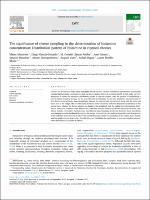Please use this identifier to cite or link to this item:
https://repositorio.usj.es/handle/123456789/1010
| Title: | The significance of cheese sampling in the determination of histamine concentration: Distribution pattern of histamine in ripened cheeses |
| Authors: | Moniente, Marta


García-Gonzalo, Diego 


Llamas-Arriba, María Goretti 
Garate, Jone 

Ontañón, Ignacio 


Jaureguibeitia, Arrate 
Virto, Raquel 
Pagán Tomás, Rafael 


Botello-Morte, Laura 


|
| Keywords: | Cheese ripening; Salt content; Moisture; Biosensor; Histamine-producing microbiota |
| Issue Date: | 18-Oct-2022 |
| Citation: | Marta Moniente, Diego García-Gonzalo, M. Goretti Llamas-Arriba, Jone Garate, Ignacio Ontañón, Arrate Jaureguibeitia, Raquel Virto, Rafael Pagán, Laura Botello-Morte, The significance of cheese sampling in the determination of histamine concentration: Distribution pattern of histamine in ripened cheeses, LWT, Volume 171, 2022, 114099, ISSN 0023-6438, https://doi.org/10.1016/j.lwt.2022.114099. |
| Abstract: | Cheeses are becoming a major safety and public health concern: cheeses available in supermarkets occasionally contain high histamine concentrations that can have negative effects on consumer health. In this study, we have attempted to assess the histamine distribution pattern in ripened cheeses, with the purpose of establishing a correct cheese sampling strategy for the quantification of histamine. To this aim, histamine was determined in four distinct areas of twelve long-ripened hard cheeses: the external and internal rind, along with the outer and inner core of the wedge. The concentrations measured were remarkably different: histamine accumulated in the central core, whereas the lowest amount was found in the peripheral rind. To explain this heterogenous distribution, histamine producers were determined in the four areas by identifying the hdc sequences obtained from cheese samples. Non-starter bacteria were identified as main histamine producers; however, these microbiota were homogeneously distributed throughout the wedge. Nevertheless, the analysis of psychochemical properties of the different areas revealed an observable trend: histamine tended to accumulate in the saltier, more humid, and less oxidized areas in a wedge. Overall, this study highlights the significance of a correct sampling strategy when histamine is quantified in cheese. |
| URI: | https://repositorio.usj.es/handle/123456789/1010 |
| ISSN: | 0023-6438 |
| Appears in Collections: | Artículos de revistas |
Files in This Item:
| File | Description | Size | Format | |
|---|---|---|---|---|
| The significance of cheese sampling in the determination of histamine concentration.pdf | 2,56 MB | Adobe PDF |  View/Open |
This item is licensed under a Creative Commons License

